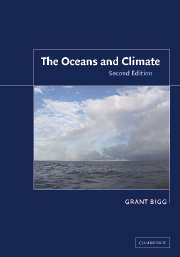Book contents
- Frontmatter
- Contents
- Preface to the first edition
- 1 The climate system
- 2 Physical interaction between the ocean and atmosphere
- 3 Chemical interaction of the atmosphere and ocean
- 4 Biogeochemical interaction of the atmosphere and ocean
- 5 Large-scale air–sea interaction
- 6 The ocean and natural climatic variability
- 7 The ocean and climatic change
- Appendices
- Glossary
- Bibliography
- Index
- References
5 - Large-scale air–sea interaction
Published online by Cambridge University Press: 05 June 2012
- Frontmatter
- Contents
- Preface to the first edition
- 1 The climate system
- 2 Physical interaction between the ocean and atmosphere
- 3 Chemical interaction of the atmosphere and ocean
- 4 Biogeochemical interaction of the atmosphere and ocean
- 5 Large-scale air–sea interaction
- 6 The ocean and natural climatic variability
- 7 The ocean and climatic change
- Appendices
- Glossary
- Bibliography
- Index
- References
Summary
This chapter examines three important climatic phenomena in which large-scale interaction between the ocean and atmosphere is a major ingredient. These are: the longitudinal biases in the positioning of tropospheric pressure systems, including associated cyclogenesis; the El Niño/Southern Oscillation phenomenon; and coupling between the ocean and atmosphere accompanying abrupt change in the thermohaline circulation. The first two of these aspects of the climate occur on a permanent, or quasi-periodic, basis and involve strong air–sea physical coupling. The third, while leading to long-term change in the climate, can occur on timescales of a few decades or less. Physical, chemical and biological interactions involving longer timescales will be explored in Chapter 6.
Tropospheric pressure systems and the ocean
In the zonal mean the troposphere has three main meridional circulation cells between the equator and the poles (§ 1.2 and Fig. 1.5). The surface pressure distribution has far more complexity than this simple model suggests, however. When scanned along a line of latitude, say 35°N, the surface pressure shows considerable variation (Fig. 5.1). In summer the oceanic longitudes show significantly higher pressure than over the continents, by up to 30 mb. In winter some continental areas exhibit higher pressures than over the oceans. This variability is due to heating and cooling affecting the continental air density. The zonal mean pressure, nonetheless, remains higher in the sub-tropics than in regions either polewards or equatorwards, in both seasons (Fig. 5.2).
- Type
- Chapter
- Information
- The Oceans and Climate , pp. 141 - 186Publisher: Cambridge University PressPrint publication year: 2003



